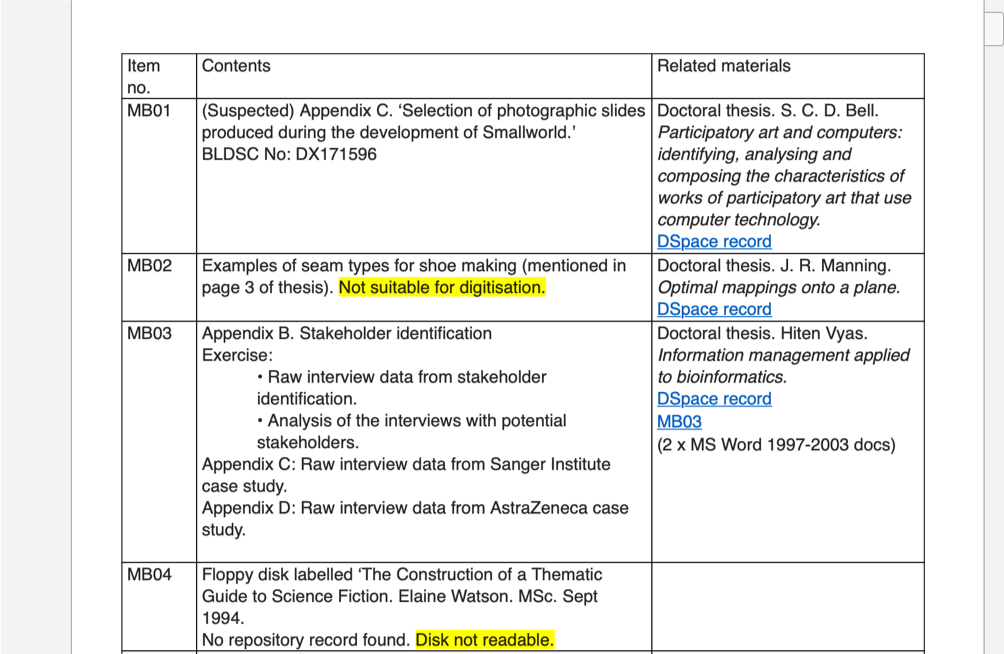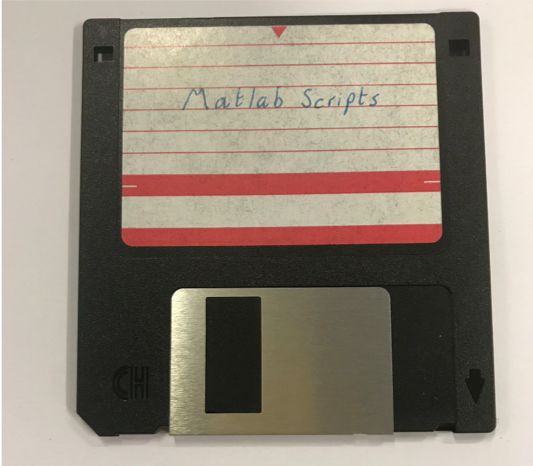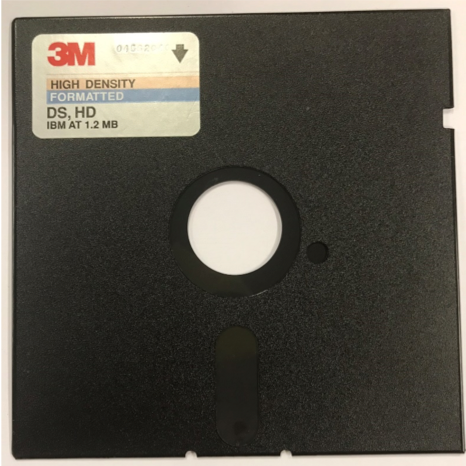Eleanor Dumbill is the Library Support Officer (Research Repository) at the University of Loughborough.
Shortly after joining the repository team at Loughborough, I was presented with a mysterious cardboard box. My colleagues were only able to tell me that the contents were generally related to past doctoral theses and that the box had been sitting under a desk in the office for at least ten years. I’ve been able to use some of my experiences investigating this box in training as an illustration of preservation formats and data management.

I set about looking into the contents and creating an asset register, giving each item a call number start ‘MB’ as I went. It quickly became clear that this would require more than just importing files to my desktop and uploading them to our repository. The box contained:
-
1 set of photographic slides
-
3 physical items (shoe prototypes & collections of printed material)
-
34 CD-ROMs
-
8 3.5 inch floppy disks
-
1 set of photo negatives
-
1 collection of radiographs
-
11 5.25 diskettes
-
1 cassette tape
-
1 computer photoset
-
1 VHS tape
-
3 collections of microfiche slides
-
1 cinefilm reel
Luckily, we still have microfiche readers and I’m reasonably familiar with using them (I moonlight as a literary historian), so I spent my first few days with the box downstairs converting the slides and radiographs into .pdf documents. I made several attempts to digitise the photographic slides, first on the microfiche and then with our office scanner. I wouldn’t care to reveal how long or how many google searches this took me, particularly as I was ultimately unsuccessful!
Our IT department were able to host me and provide me with an off-network PC that still had a floppy disk reader, and an external diskette reader. I have to say, using this PC with Windows 98 was quite the nostalgia hit and made me wish SkiFree were installed so I could really relive my misspent youth. Instead, I spent a good few hours trying to persuade this computer that it really did want to read these disks and entertaining my colleagues from IT, who were equal parts bemused as to why I was even doing this and amused when I resorted to the classic trick of blowing on disks before inserting them. I left about half of the 5.25”s with them as I’d been unable to coax them into working and headed back a couple of weeks later to collect them when it was clear nobody would be able to.
As one might expect, the CDs were the easiest items to process but these weren’t without difficulties. There were the usual scratched disks, password protected items, and files in formats that are no longer supported. Where I could read the disks, I created a sub-folder with the call number in the ‘Mystery Box’ folder that I had already shared with colleagues and used DROID to enumerate what was inside. I also created a .zip file of the folder contents ready for upload to the repository.


In the end, I was able to digitise everything except the cassette tape, VHS, and the cinereel. I debated revisiting the old-fashioned piracy technique of simply playing the cassette and using a digital recorder to capture its contents, but decided to wait and see
whether we could access proper digitisation tools. I had a similar degree of success with a second mystery box, which turned up on my desk a few months later upon the retirement of another colleague.
Getting everything into digital form was only the first step. Once this was done, I had the surprisingly difficult task of figuring out exactly which thesis each file was related to and whether it was suitable for upload to the repository. This was made significantly trickier by most of the depositors’ refusal to label their files with anything like helpful information. A few stood out as exemplars, printing on the CD slip or writing on the floppy exactly what was on the disk, what it related to, and how it could be accessed, but these were vastly outnumbered by those who refused to give even their names.
My experience preserving the mystery box was a great practical example of some simple DigiPres truths and, as I stated above, I’ve been able to pass these on in training. I’m sure these are familiar to members of the DPC but it’s useful to emphasise how important it is to:
-
Consider the long term availability of storage media
-
Give these media detailed labels










































































































































